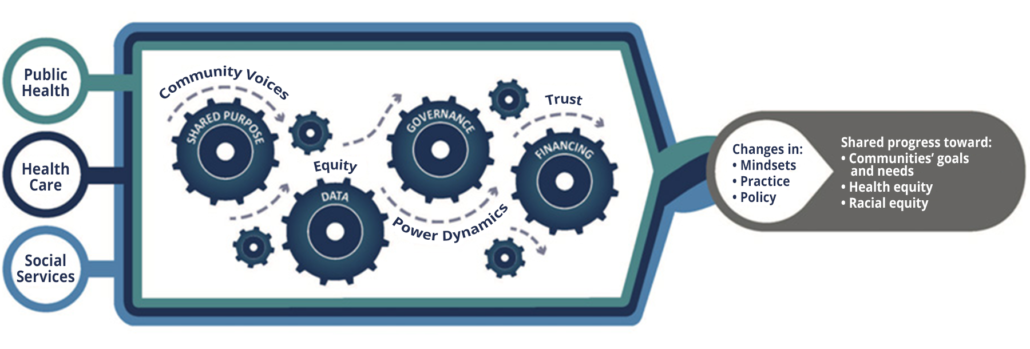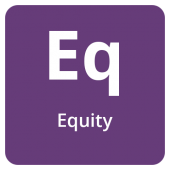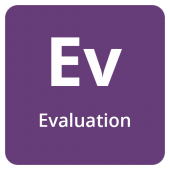Just as sources, uses, and structure are intertwined components of a local wellness fund, other foundational factors, too, are interconnected and will impact the ability of partners and the community to work together to meet community needs through a local wellness fund.
Efforts to tackle pervasive, long-standing population health challenges require collaboratives to work together in new, sustainable ways. This recognition is at the core of local wellness funds’ mission to support community well-being and clinical prevention efforts that improve outcomes and reduce health inequities. Local wellness funds are one example of how partners and multi-sector collaboratives can align across sectors to achieve a shared vision for lasting impact.
To learn more about each element, select the name of the element.

This framework recognizes the importance of four core components that support the structure of aligning, including:
- Shared purpose
- Data and measurement
- Governance
- Financing
Additionally, four adaptive factors — community voice, data, power dynamics, and trust — are integral to the functioning of the core components and the ability to ultimately successfully align across sectors.
The Framework for Aligning Sectors theorizes that aligning increases as health care, public health, and social services develop these four components and strengthen the adaptive factors, and conversely, that sustained alignment is less likely if these elements are not put into practice.
Synergies Between Frameworks for Local Wellness Funds and Aligning Systems for Health
Just as sources, uses, and structure are intertwined in local wellness funds, the core components and adaptive factors, too, are interconnected, nonlinear, dynamic, and reinforcing in efforts that align across sectors.
Aligning across sectors is a feature of most local wellness funds, and cannot be created quickly. Aligning efforts broadly, and local wellness funds specifically, can create shared progress across interim points, while keeping the shared progress toward meeting communities’ goals and needs, health equity, and racial equity in the long-view. To achieve these distal outcomes, there must be changes in mindsets, practices, and policies that along the way. Aligning across sectors, as well as each of its core components and adaptive factors can be thought of as a spectrum of effort, rather than all-or-nothing ambitions.
The Framework for Aligning Sectors provides local wellness funds another way to think about the foundational elements that will strengthen the ability of partners and community to work together to advance community well-being through the growth of the local wellness fund.

Community voice
Community voices can be included in many local wellness fund processes and principles, like sharing power and applying an equity lens. Community engagement can help local wellness funds to build trust, gain buy-in, and develop accountability with the impacted community they serve. In the real world, incorporating community voice and building community capacity for engagement are not binary yes-or-no activities, and the collaborative supporting a local wellness fund can think of community voice activities as a spectrum — from one-way information sharing to full participation in decision-making and allocation of resources.

Equity
There is no single definition of equity, no single measurement of equity, and certainly no known strategy to achieve it. Equity, as measured by both processes and outcomes, can be thought of as a continuum from inequitable to fully equitable. Local wellness funds can move along this continuum by incorporating equity-focused strategies for knowledge building and vision sharing, assessment and measurement, and action. But, a health equity mindset is difficult to accomplish without a deep understanding of the groups in the community that are experiencing the conditions that are creating disparities, including learning directly from those with first-hand knowledge and experience.

Evaluation
There are two key components to evaluating a local wellness fund: 1) assessing the structure and process of the local wellness fund (a process evaluation) and 2) measuring impact of the local wellness fund (an outcomes evaluation for the fund as a whole and individual investments). Qualitative and quantitative data from both the process and outcomes evaluations will tell the story of the local wellness fund: how, why, and impact. This story is central to making the case for the local wellness fund, expanding partnerships and resources, and ensuring sustainability of the local wellness fund.

Sustainability
Given the scant number of wellness funds and the fact that most have been established recently, there is little evidence directly of factors affecting sustainability of local wellness funds. Yet, many of the elements recognized to be crucial to sustainability generally, are in the control of local wellness funds. Long-term sustainability is possible with effective planning beginning in the early, initial design phase of a new initiatives.
Framework for Aligning Sectors
The Framework for Aligning Sectors, developed as part of the Aligning Systems for Health initiative with support from the Robert Wood Johnson Foundation, graphically depicts the foundational structure for sectors to sustainably work together in new ways and create shared movement toward meeting communities’ goals and needs. Aligning across sectors emphasizes coordination that extends beyond working together on a single project.

This framework recognizes the importance of four core components that support the structure of aligning, including:
- Shared purpose
- Data and measurement
- Governance
- Financing
Additionally, four adaptive factors — community voice, data, power dynamics, and trust — are integral to the functioning of the core components and the ability to ultimately successfully align across sectors.
The Framework for Aligning Sectors theorizes that aligning increases as health care, public health, and social services develop these four components and strengthen the adaptive factors, and conversely, that sustained alignment is less likely if these elements are not put into practice.
Synergies Between Frameworks for Local Wellness Funds and Aligning Systems for Health
Just as sources, uses, and structure are intertwined in local wellness funds, the core components and adaptive factors, too, are interconnected, nonlinear, dynamic, and reinforcing in efforts that align across sectors.
Aligning across sectors is a feature of most local wellness funds, and cannot be created quickly. Aligning efforts broadly, and local wellness funds specifically, can create shared progress across interim points, while keeping the shared progress toward meeting communities’ goals and needs, health equity, and racial equity in the long-view. To achieve these distal outcomes, there must be changes in mindsets, practices, and policies that along the way. Aligning across sectors, as well as each of its core components and adaptive factors can be thought of as a spectrum of effort, rather than all-or-nothing ambitions.
The Framework for Aligning Sectors provides local wellness funds another way to think about the foundational elements that will strengthen the ability of partners and community to work together to advance community well-being through the growth of the local wellness fund.
To learn more about each topic, select the element box.
In examining both the sources, uses, structure framework that underpins local wellness funds and the Framework for Aligning Sectors that can guide cross-sector collaborative efforts, there are some recognized cross-cutting factors that will impact the success of local wellness funds.
Community voice
Community voices can be included in many local wellness fund processes and principles, like sharing power and applying an equity lens. Community engagement can help local wellness funds to build trust, gain buy-in, and develop accountability with the impacted community they serve. In the real world, incorporating community voice and building community capacity for engagement are not binary yes-or-no activities, and the collaborative supporting a local wellness fund can think of community voice activities as a spectrum — from one-way information sharing to full participation in decision-making and allocation of resources.
Equity
There is no single definition of equity, no single measurement of equity, and certainly no known strategy to achieve it. Equity, as measured by both processes and outcomes, can be thought of as a continuum from inequitable to fully equitable. Local wellness funds can move along this continuum by incorporating equity-focused strategies for knowledge building and vision sharing, assessment and measurement, and action. But, a health equity mindset is difficult to accomplish without a deep understanding of the groups in the community that are experiencing the conditions that are creating disparities, including learning directly from those with first-hand knowledge and experience.
Evaluation
There are two key components to evaluating a local wellness fund: 1) assessing the structure and process of the local wellness fund (a process evaluation) and 2) measuring impact of the local wellness fund (an outcomes evaluation for the fund as a whole and individual investments). Qualitative and quantitative data from both the process and outcomes evaluations will tell the story of the local wellness fund: how, why, and impact. This story is central to making the case for the local wellness fund, expanding partnerships and resources, and ensuring sustainability of the local wellness fund.
Sustainability
Given the scant number of wellness funds and the fact that most have been established recently, there is little evidence directly of factors affecting sustainability of local wellness funds. Yet, many of the elements recognized to be crucial to sustainability generally, are in the control of local wellness funds. Long-term sustainability is possible with effective planning beginning in the early, initial design phase of a new initiatives.
Community engagement and collaboration can lead to a larger collective impact, but first collaboratives need to create the right environment for conversations to establish shared goals. Born says, “I love conversations – especially big, messy, and purposeful ones.” Born sees conversation as a larger process of change. His book provides an understanding of the building blocks of community conversations (e.g., conversing, engaging, collaborating, and casting a vision), as well as 10 techniques for community conversations that local wellness funds can employ.
California Accountable Community for Health Initiative’s Core Element Assessment Tool is designed to help local collaboratives develop a shared understanding of their strengths, capacities, and gaps across multiple dimensions, which we define as readiness to launch an Accountable Communities for Health (ACH). Local wellness funds may find it helpful to assess their readiness around some or all of the seven core elements of ACHs, including shared vision and goals, partnerships, leadership, backbone, data analytics and capacity, wellness fund development, and portfolio of interventions.
Return on Investment Calculator for Partnerships to Address the Social Determinants of Health
This calculator, by the Commonwealth Foundation, is designed to help community-based organizations and their health system partners plan sustainable financial arrangements to fund the delivery of social services to high-need, high-cost patients. Local wellness funds may find this a useful tool to explore as they begin to explore how to assess return on investment in their local context.
This brief, by the California Accountable Communities for Health Initiative, documents early insights on critical dimensions of wellness fund development, including governance, funding sources, and administrative models and key capacities. CACHI sees wellness funds as a way to unlock new partnerships and strategies for sustainably addressing complex health and health equity priorities. These insights may help local wellness funds address sustainability in their own local context.
Partnership Assessment Tool for Health: Advancing Health Equity
Nonprofit Finance Fund developed an addendum to their Partnership Assessment Tool for Health that focuses on partnerships’ ability to advance health equity. This new section identifies benchmarks characteristic of partnerships working effectively to advance health equity, as well as guiding questions for partnerships to consider in assessing their development in this area. Local wellness funds may find the questions useful to open dialogue within and between partnering organizations around strengths and gaps of the partnership in removing obstacles to health and ensuring opportunities for all.


















